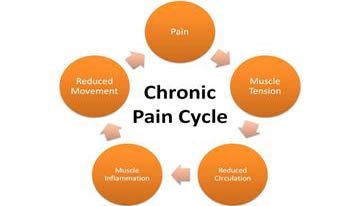About Chronic Pain
 Chronic pain is described as any pain which lasts for longer than the damage to the tissue would be expected to last. This is generally accepted to be anything longer than 3 months, as tissues healing takes 6 to 12 weeks. The International Association for the Study of Pain (IASP) defines chronic pain as “pain without apparently biological value that has persisted beyond the normal tissue healing time.”
Chronic pain is described as any pain which lasts for longer than the damage to the tissue would be expected to last. This is generally accepted to be anything longer than 3 months, as tissues healing takes 6 to 12 weeks. The International Association for the Study of Pain (IASP) defines chronic pain as “pain without apparently biological value that has persisted beyond the normal tissue healing time.”
The incidence of chronic pain is high, making it an important issue. A survey of 10 developed and 7 developing countries suggests that the prevalence of chronic pain among adults is 41% and 37% respectively.
Chronic pain is associated with considerable loss of quality of life and employment and enormous cognitive, social, and economic costs. Chronic pain conditions were four of the 10 highest ranking conditions for years lived with disability in 2013. Despite this, the term 'chronic pain' was only added as an official MeSH term in MEDLINE in January 2012. Patients with chronic pain can often feel misunderstood and tend to try many treatment options as they struggle to find anything that works.
Chronic pain can affect any body part. As the mechanism is still largely unknown, there is insufficient ability to predict if an acute injury will become chronic. However, certain factors can contribute to an increased risk of chronic pain. These include:
- female gender
- older age
- lower socioeconomic status
- geographical and cultural background and
- genetics
Other factors associated with chronic pain conditions are modifiable, such as
- smoking status
- alcohol intake
- nutrition
- obesity
- comorbidities
- employment status and occupational factors and
- physical activity level.
It is known that the most common form of chronic pain is lower back pain. Therefore, is it vital that acute lower back pain is managed immediately. Chronic leg pain is often referred from the lower back so it is also very common.
Chronic hand pain tends to become CRPS and have many other systematic symptoms and again the evidence points to early management and treatment. For all chronic pain syndromes, relief from chronic pain becomes more difficult as the duration of chronic pain increases.
Non-invasive human brain imaging studies have allowed researchers to study the brains of chronic pain patients. These studies show enhanced activity in the emotional and motivational parts of the brain. This provides evidence of the complex nature of chronic pain. It allows a wider picture of pain to include psychogenic pain models. It also gives some idea as to why the traditional methods of treating the pain may not be effective.
Traditional treatments are often derived from acute pain models but chronic pain, unlike acute pain, is often associated with alterations in the brain. One study has suggested that if treatment is tailored to the individual, including psychogenic pain, it may become possible to reduce the intensity of pain and shorten the duration of pain.